![]()
![]()
![]()
Use LEFT and RIGHT arrow keys to navigate between flashcards;
Use UP and DOWN arrow keys to flip the card;
H to show hint;
A reads text to speech;
15 Cards in this Set
- Front
- Back
|
Ulluchu |
Banners of gilded metal (cult images?) that have a border of plaques with embossed paisley-shaped motifs thought to represent plant life |
|
|
Backflap |
Key royal ornament; thin sheets of metal, often decorated at the top in bas-relief and inlay; may have served as a type of body armor |
|
|
Tumi |
A knife with a curved edge blade, typically used in ceremonies |
|
|
Drawing of Sacrifice Ceremony (pg. 93) 100 BCE - 700 CE, EIP Depicts a captive's blood being offered to Lord Sipan by a priest (owl iconography), priestess in attendance; A restoration of order. Depicts actual people, or at least the roles they took on - similar illustrations of these people have been found in the tombs at Sipan "Fineline" - similar to that of Greek vases, fill-in silhouettes, full of energy utilizing the dynamic asymmetry of profile figures |

|
|
|
Reconstruction of Huaca de la Luna (pg. 99) 100 BCE - 700 CE, EIP "Pyramid of the Moon"; Huaca = Quechua word referring to an object or place in which sacred power was immanent Enormity was an Early Intermediate Period trait Patios, storerooms, and workshops were all connected by plazas and streets Consisted of 4 plazas and 3 main platforms - platforms I & II joined, and III was apart on higher ground Bright murals and painted reliefs found, indicating colorful decor Constructed from millions of adobe bricks, made of molded, smoothed, and sun-dried mud --> this technique was only possible on such a scale because the Mocha could obtain water from multi-valley sources and control work parties - 50 million bricks went into this structure |
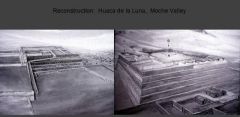
|
|
|
Panamarca mural showing Sacrifice ceremony (pg. 101) 100 BCE - 700 CE, EIP Violent sacrifice - presenting the blood of victims to a main priest, priestess to the left wearing a distinct headdress and tunic. The smaller celebrants bring her goblets, while she in turn may be offering her goblet to the Lord of Sipan |
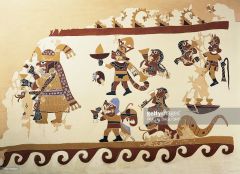
|
|
|
Fig 77. Reconstruction of Pyramids at Sipan (pg. 96) c. 300 CE, EIP Progression in coastal building: early U-shaped structures were oriented toward the mountains, then centers were built in or on the foothills, and finally, the Moche basically erected their own mountains on the coast - Moche is only 3 miles from the sea; their formations were not only shaped like, but nearly the scale of natural formations Enormity was an Early Intermediate Period trait |
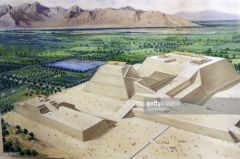
|
|
|
Earspool (pg. 104) 100 BCE - 700 CE, EIP Gold and turquoise imported from southern region Inlay and lost wax casting, sheet metal (combination of techniques) Attached by small wires to make it kinetic --> insane the amount of workmanship for such a small scale to work with Depicts the Lord buried in the tomb (6 found in tomb 1) |
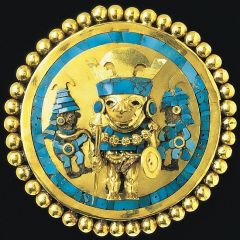
|
|
|
Peanut necklace (pg. 104) 100 BCE - 700 CE, EIP Peanut was their main crop, prestigious commodity Dualism: silver (feminine, night/moon) and gold (masculine, day/sun) |
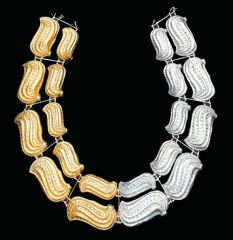
|
|
|
Reconstruction of Warrior Priest burial, 100 BCE - 700 CE, EIP Status/occupation could be determined by what you were buried with - craftsmanship of the objects, specific items pertaining to social/economic role in life, and how many people you were buried with Warrior Priest's tomb is more modest than tomb of Warrior Lord - chamber slightly smaller, not buried with as many people, items, or clothing COPPER - associated with the priest |
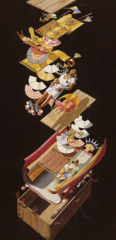
|
|
|
Gilded copper banner, 100 BCE - 700 CE, EIP |
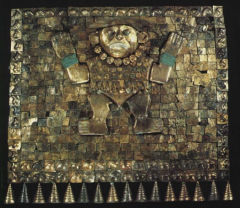
|
|
|
Portrait head vessel of “cut-lip” (pg. 114) 100 BCE - 700 CE, EIP Over 45 portraits of the same man, noted for a scar on his lip 1st depicted around age 10 or 12 Scars perhaps show early training to fight and often winning Able to see how this man aged |
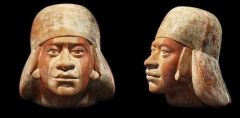
|
|
|
Fig. 16 of Donnan article: full-figure portrait vessel 100 BCE - 700 CE, EIP |

|
|
|
Fig. 18 of Donnan article: full-figure portrait vessel of captive, 100 BCE - 700 CE, EIP Some full-figure portraits show high-status men who later became captives, stripped of their finery and wearing ropes around their necks --> helps to build the case that much Moche sacrifice was not of foreigners in battle, but rather of Moche individuals, even powerful ones. To sacrifice the powerful and well known was a gesture of supreme, perhaps spiritual as well as political dominance |

|
|
|
Compare and contrast Moche art and Chavin art and architecture |
Differences: Moche: tells a story/narrative, intimate relationship between secular and spiritual, more theatrical - sense of everyone is coming together to watch something, mass production of art (molds) - individuality (signatures) v. communal effort/standardization, style uses naturalism as a basis for its messages about the many levels of existence, more attention given to faces than bodies (individuality), art is very active and transitive Chavin: secular and spiritual were kept separate (communal v. private), more of a participatory, psychotropic drug use Similarities: Repeated images, relief work, bold contrasting colors, presence of human sacrifice, UKHU = layering/recalling the importance of that which is inside |

